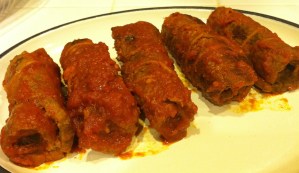 OK, confession: this is not a Cooking With Josh recipe. I made this one late last night, long after Josh went to bed, so that it would be ready for Easter morning. This one I would call Cooking With Nonna.
OK, confession: this is not a Cooking With Josh recipe. I made this one late last night, long after Josh went to bed, so that it would be ready for Easter morning. This one I would call Cooking With Nonna.
When I was a kid, my grandmother baked what we always called pizza gaina, which apparently doesn’t really exist. It’s actually a dialect or two removed from the Neapolitan pizza chiena, which is dialect for pizza ripiena, or stuffed pizza…
Which is really supposed to be called pizza rustica.
But all of that is academic. In my heart–and in my stomach–I know that this dish is really pizza gaina.
I’m not positive, but I think I might be the only one of the grandkids who has made this. And as far as I know, no one (including my mother) has anything resembling a recipe. I scoured the web and found this one, adapted from Carlo’s Bakery in New Jersey. I subtracted out the things that I didn’t remember my nonna using and adjusted other ingredients accordingly. What cooked up was a pretty good imitation of the pizza gaina that lives in my memory.
The Dough
6-7 cups flour
1 lb butter
1/4 teaspoon salt
1/4-1/2 cup cold water
5 eggs
The Filling
1 lb cooked ham, cut in bite-size chunks
1/2 lb hard salami, cut in bite-size chunks
1/2 lb soppressata, cut in bite-size chunks
1/2 lb provolone, cut in bite-size chunks
1/2 lb mozzarella, cut in bite-size chunks
4 ounces grated pecorino romano cheese
2 lbs ricotta cheese
10 eggs, plus one additional egg for glazing
1/2 teaspoon black pepper
Combine the flour and salt. Cut the butter into small chunks and mix it in with the flour and salt until the mixture is the texture of sand. Beat the eggs and add it to the mixture. Knead the dough. Slowly add additional cold water, as needed, until your dough holds together. Knead for several minutes, then wrap in plastic wrap and store in the refrigerator for at least a half hour.
Preheat the oven to 350 degrees.
In a large bowl, beat 10 eggs. Add the ricotta, grated cheese, and pepper, and combine. Stir in the remainder of the ingredients.
Cut the dough into two portions, approximately 2/3 and 1/3. Take the larger piece and roll it out to about a 1/4 inch, until it is big enough to cover the bottom and sides of a 15″x 11″ glass dish. Line the dish, making sure to work the dough into the corners. Add in the egg, cheese, and meat mixture. Roll out the remainder of the dough and cover the top, making sure to seal the edges.
Bake for about 45 minutes, then glaze the top with an egg wash. Return to the oven and bake for about another half hour to 45 minutes. You can cover the top with foil if it starts to look too brown.













